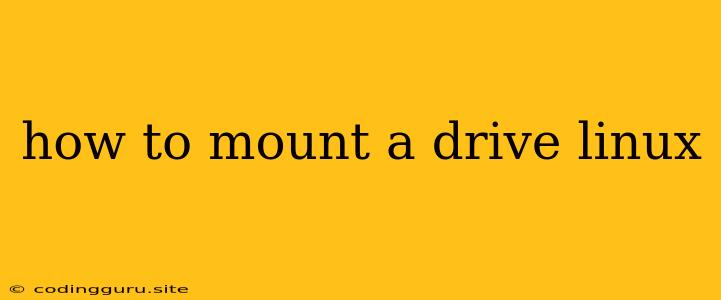How to Mount a Drive in Linux: A Comprehensive Guide
Linux is a versatile operating system renowned for its flexibility and command-line prowess. One of its key features is its ability to mount various storage devices like hard drives, USB drives, and network shares. This process, known as mounting a drive, allows you to access the files and directories stored on the device within the Linux file system.
Why is Mounting a Drive Necessary?
Before you can work with files on a drive, you need to mount it. Think of it as connecting the drive to the Linux file system. Without mounting, the drive would be inaccessible to the system.
Understanding the Basics of Mounting
- Mount Point: This is a directory within your Linux file system where the drive will be "mounted." It acts as the entry point for accessing the files on the drive.
- Device Name: This identifies the specific drive you want to mount. You can find it using the
lsblkcommand, which lists all the block devices connected to your system. - File System: This refers to the way the data on the drive is organized. Common file systems in Linux include ext4, NTFS, and FAT32.
Methods to Mount a Drive in Linux
Here's a breakdown of different ways to mount a drive in Linux:
1. Using the mount Command
This is the most common and direct method. Here's how to use it:
sudo mount /dev/sdX /mnt/drive_name
- Replace
/dev/sdXwith the actual device name of your drive. You can identify this usinglsblk. /mnt/drive_nameis the mount point. You can choose any directory you want.
Example:
sudo mount /dev/sdb1 /mnt/data
This command mounts the partition /dev/sdb1 to the directory /mnt/data.
2. Automatically Mounting with fstab
The /etc/fstab file provides a list of filesystems and how they should be mounted. You can add a line to fstab to automatically mount a drive at system startup. Here's an example entry:
/dev/sdb1 /mnt/data ext4 defaults 0 2
/dev/sdb1: Device name./mnt/data: Mount point.- ext4: File system type.
- defaults: Mount options (e.g.,
defaults,rw,ro). - 0 2: Dump and pass options for system backup tools.
3. Using GUI File Managers
Many Linux desktop environments offer graphical interfaces for mounting drives. Look for the "Mount" or "Devices" section in your file manager.
4. Mounting Network Shares
To access files shared on a network, you can use the mount command with the smbfs or cifs file system. Here's an example:
sudo mount -t cifs //server_ip/share_name /mnt/share
-t cifs: Specifies thecifsfile system.//server_ip/share_name: The network share address./mnt/share: The mount point.
You might need to provide login credentials if the share is password protected.
Important Considerations:
-
Permissions: When mounting a drive, make sure you have the necessary permissions to access its contents. You may need to use
sudoto gain root privileges. -
File System Compatibility: Ensure the file system of the drive is supported by Linux.
-
Unmounting Drives: Always unmount a drive before removing it or powering down your system. Use the
umountcommand:sudo umount /mnt/drive_name
Tips for Mounting a Drive in Linux:
- Create a separate mount point: Avoid mounting directly to your
/homedirectory. - Check file system integrity: Use the
fsckcommand to check the drive for errors before mounting it. - Use automounting: This simplifies the mounting process, but remember to update
fstabaccordingly. - Consider file system options: Use mount options like
ro(read-only) ornoexecto enhance security or restrict access.
Troubleshooting:
- No device found: Verify the device name is correct.
- Permission denied: Use
sudoor adjust permissions on the mount point. - File system errors: Run
fsckto repair the file system. - Incorrect file system type: Double-check the file system of the drive.
Conclusion:
Mounting a drive in Linux is a fundamental task that enables you to access data stored on various devices. By understanding the different methods and key considerations, you can seamlessly integrate drives into your Linux system and manage your data with ease. Remember to always unmount drives properly to prevent data corruption.
